 Society
Society

 |
| Farmers harvest clams in Tiền Giang Province’s Gò Công Đông District. — VNA/VNS Photo Hữu Trí |
TIỀN GIANG — Coastal areas in Tiền Giang Province have effectively implemented aquaculture production to adapt to climate change and improve farmers’ income.
The Cửu Long (Mekong) Delta province normally faces saltwater intrusion from the sea through rivers in the dry season which affects agricultural production and the lives of locals.
To cope with saltwater intrusion, the province has developed brackish and saltwater aquaculture in coastal areas to stabilise the lives of locals and adapt to climate change.
The province’s coastal districts of Gò Công Đông, Gò Công Tây and Tân Phú Đông have bred nearly 11,000ha of brackish and saltwater aquaculture to serve domestic consumption and exports so far this year.
The districts have harvested nearly 42,000 tonnes of seafood, mostly black-tiger shrimp, white-legged shrimp and clams.
Bùi Thái Sơn, chairman of the Tân Phú Đông District People’s Committee, said Tân Phú Đông is located downstream from the Tiền River and borders the sea, and these are favourable conditions for the district to develop brackish and saltwater aquaculture sustainably.
The district has zoned 5,000ha for aquaculture in coastal areas, accounting for nearly 40 per cent of its total farming area, he said.
It has provided intensive farming techniques for farmers and encouraged them to switch from outdated traditional breeding models to those that use advanced techniques that adapt to climate change, are environmental friendly and have high profits, he said.
The advanced breeding models include high-tech industrial shrimp farming, intensive shrimp farming, shrimp-rice farming and shrimp-crab-fish farming.
Farmers in the district have bred two aquaculture crops with a combined area of 7,280ha so far this year, harvesting more than 26,000 tonnes of seafood, up nearly 9,500 tonnes year-on-year, according to the district’s Bureau of Agriculture and Rural Development.
Black tiger shrimp, white-legged shrimp, clams and other bivalve molluscs are the district’s key seafood products.
Phạm Văn Lẹ has a 3ha shrimp farm in Tân Phú Đông’s Phú Thạnh Commune and breeds three crops of white-legged shrimp a year.
Each crop takes about 100 days.
He harvests a total of 24 tonnes of white-legged shrimp a year and earns a profit of VNĐ1-1.2 billion (US$40,000-48,000), he said.
In Gò Công Đông District, farmers have bred black tiger shrimp and white-legged shrimp on nearly 850ha so far this year, according to the district’s Bureau of Agriculture and Rural Development.
The district has 2,200ha of clam farming area in Tân Thành Commune. The clam farming area has developed eco-tourism services, helping to improve the income of farmers.
Farmers in Gò Công Đông have harvested nearly 15,000 tonnes of shrimp and clams so far this year.
To help the coastal districts promote their advantages and strengths in developing brackish and saltwater aquaculture, the provincial Department of Agriculture and Rural Development has provided advanced techniques for them and encouraged farmers to breed shrimp under hi-tech farming methods, such as two-stage industrial shrimp farming.
Two-stage industrial shrimp farming uses super intensive farming, has high yields, is environmental friendly and adapts to climate change.
The province has nearly 300ha of hi-tech shrimp farming areas that offer a high yield of 40-60 tonnes per hectare a crop, about 10 times higher than traditional breeding techniques, according to the department. VNS




